Introduction
NFV in ETSI
Founded in November 2012 by seven of the world's leading telecoms network operators, ETSI ISG NFV became the home of Network Functions Virtualisation (NFV).
Almost seven years and over 100 publications later, the ETSI ISG NFV community has evolved through several phases, its publications have moved from pre-standardization studies to detailed specifications (see Release documentation). The early Proof of Concepts (PoCs) efforts have evolved and led to a series of interoperability events (NFV Plugtests). This large community is still working intensely to develop the required standards for NFV transformation incorporating latest technologies, as well as sharing their experiences of NFV implementation and testing in multi-vendor environments.
ETSI ISG NFV, like any other ETSI Industry Specification Group is open to ETSI members and non-members alike, with different conditions depending on ETSI membership status. If you would like to participate in this work, please contact the NFV support team.
Building and Managing Softwarized Network Functions
Modern telecoms networks contain an ever-increasing variety of proprietary hardware. The launch of new services often demands network reconfiguration and on-site installation of new equipment which in turn requires additional floor space, power, and trained maintenance staff.
In a digital world, the innovation cycles accelerate and require greater flexibility and dynamism than hardware-based appliances allow. A hard-wired network with single functions boxes is tedious to maintain, slow to evolve, and prevent service providers from offering dynamic services.
In the same way that applications are supported by dynamically configurable and fully automated cloud environments, virtualized network functions allow networks to be agile and capable to respond automatically to the needs of the traffic and services running over it.
Key enabling technologies for this vision include SDN (Software Defined Networking) and NFV (Network Functions Virtualisation). SDN and NFV are complementary but increasingly co-dependent. While the former provides the means to dynamically control the network and the provisioning of networks as a service, the latter offers the capability to manage and orchestrate the virtualization of resources for the provisioning of network functions, either deployed in virtual machines or OS containers, and their composition into higher-layer network services.
Our Role & Activities
Overview
ETSI ISG NFV undertakes work in 2-year phases.
Documents published during the first phase (2013-2014) were considered as pre-standard studies and are sometimes referred to as “Release 1”.
The ISG NFV community has continued its work by developing normative specifications, as well as informative studies. The specification of new features and capabilities in planned releases had as outcome subsequent tranches referenced as "Release 2", "Release 3", etc.
Going forward, the ISG NFV continues to develop new specifications that meet the needs of the industry, with maintenance cycles for its already published specifications. The ISG NFV dedicates a continuous support for proper referencing of NFV specifications by industry stakeholders, including not only service providers or network equipment vendors, but also other implementers such as open-source communities. Progress in the industry is continuously monitored, including feedback from implementations, open-source communities, and other standards bodies, and the identification of gaps to be addressed.
Abbreviations of the NFV working groups mentioned in this page:
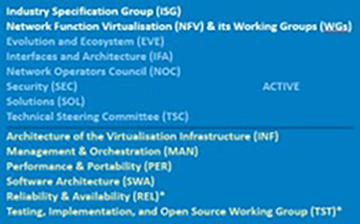
* The REL working group has merged with IFA and TST has merged with the SOL Working Groups.
Started 2023: NFV Release 6
Release 6 focuses on architecture and infrastructure with interfaces, modeling, etc. to extend current features and new features such as (not exhaustive list):
- Architecture evolution and simplification.
- New infrastructure.
- New virtualization forms.
- Latency aspects.
Started 2021: NFV Release 5
NFV Release 5 builds on top and leverages the results of ETS ISG NFV documents published as part of the Release 4. The Release 5 introduces new features on top of the specified capabilities and features in previous Releases and continues features not completed in Release 4.
- Network connectivity integration and operationalization for NFV - container networking enhances the NFV architectural framework to provide support for multiple networks connectivity for OS container-based VNF.
- NFV-MANO automation and autonomous networks, the scope of the feature covers the following areas: NFV-MANO support for managing autonomous networks, enabling higher level of automation for NFV-MANO, intent-based principles for external exposure network services management.
- NFV enhancements for 5G, the feature enhances the NFV architectural framework to further support 5G network deployments.
- Multi-tenancy enhancements for NFV-MANO, the scope of the feature covers the following areas: multi-tenancy technology to share IT resources securely among multiple tenants that use the cloud, virtualization-based features as a means to isolate tenants, association/disassociation of tenancy and NFV-MANO objects, definition of isolation expectations of tenants, management of tenants.
- VNF generic management functions, the feature analyses and defines the type of OAM functions for VNFs that can be generalized and be provided as a "generic function" supporting the provisioning, connectivity, configuration, testing and monitoring of VNFs on a virtualized platform.
- Policy management models, the feature defines the models necessary for policy management, while the architectural enhancements for the introduction of the policy framework and the specification of a policy engine, with its procedures, interfaces and handling of the input events, goals and output/actions is not in scope of this feature.
- NFV for vRAN, The scope of this feature covers the following areas: study the advances concerning the virtualization of the RAN and profile the NFV framework to determine how it can support virtualized RAN (vRAN) use cases, • identify key technical challenges relevant to architectural, operational and management aspects, in case the NFV architectural framework is leveraged to support virtualization of the RAN, • provide recommendations for enhancements to the NFV architectural framework and its functionality, aiming to provide further support for vRAN use cases, • based on the recommendations, enhance when needed the overall NFV-MANO framework, existing NFV-MANO interfaces and descriptors.
- Green NFV, the scope of the feature covers the following areas: analyse aspects of NFV (VNF design, NFV-MANO and VNF operation, deployment configuration of NFV-MANO, NFVI, etc.) that have impact on energy consumption and those that can enable smart energy NFV and power saving features, identify design guidelines needed for optimizing energy consumption, specify enhancements to specifications on interfaces and information model, augment exposed KPIs and metrics to enable resources orchestration and VNF/NS LCM to operate following power saving policies.
- VNF configuration, the scope of this feature covers the following areas: provide guidelines on the use of the configuration options available in the NFV framework and the types of configuration data applicable to each of these options, specify related enhancements to the set of ETSI NFV specifications needed to improve interoperability between VNFs and independently-developed VNF configuration management functions and further facilitate automation of VNF configuration.
- Flexible VNF deployment, the feature has two parts: deployable modules and dynamic capacity. The deployable modules part was added late to Release 4. The dynamic capacity part introduces support for parameterizing the VDU attributes related to capacity in the interfaces.
- Physical Infrastructure Management, the scope of the feature covers the following areas: define requirements for physical infrastructure management in the NFV-MANO framework, provide a common information model for describing hardware attributes and statuses, and specify operations for managing infrastructure hardware with respect to life cycle and FCAPS of physical resources, profile existing solutions related to hardware management.
- VNF management gaps with Open Source, will produce a report on VNF management gap analysis with open source projects.
The "Release 5 Definition" lists all the new features proposed for the Release 5.
Similarly, as in the previous Release, the completion of the specification of features in Release 5 at different stages follows a phased approach, commonly referred to as "drops".
Started 2019: NFV Release 4
NFV Release 4 specification work has been formally launched in summer 2019. While the specific work items are under progress, key areas of focus for the future NFV Release 4 have been identified, which include:
- NFVI evolution, focusing on enhancements to support lightweight virtualization technologies such as OS containers, optimizing NFV Infrastructure (NFVI) abstraction for reducing the coupling of VNFs to infrastructure, and optimizing networking integration into the infrastructure fabric to ease the connectivity for Virtualized Network Functions (VNFs) and Network Services (NSs)
- Enhancing NFV automation and capabilities, covering aspects such as: improving life-cycle management and orchestration, introducing more policy-based management, the simplification of VNF and NS management aspects leveraging virtualization, and handling advances in autonomous networking
- Evolving the NFV-MANO (Management and Orchestration) framework, focusing primarily on optimizing internal NFV-MANO capability exposure and usage, e.g. studying its service-based transformation
- Enhanced reliability and availability introduced via features like NFV-MANO upgrades and MANO robustness
- Accompanying operationalization aspects which include: the simplification of NFV to ease development and deployment of sustainable NFV based solutions, verification (and certification) procedures and mechanisms, and operationalization, integration and use of NFV with other management and network frameworks
- In addition to the above technical areas, several security hardening aspects of NFV and other small specific technical enhancements necessary to maximize the impact of virtualization and future NFV deployments are also expected to be part of the work programme
The "Release 4 Definition" lists all the new features proposed for the Release 4.
List of new features in Release 4:
- Network connectivity integration and operational for NFV
- NFV-MANO automation and autonomous networks
- NFV enhancements for 5G
- Multi-tenancy enhancements for NFV-MANO
- Service-based architecture (SBA) for NFV-MANO
- VNF generic management functions
- Continuous VNF integration, and
- Policy models
The set of Release 3 features that had been carried over into Release 4 (had not been fully completed in Release 3) comprises:
- NFV-MANO software modification
- Multi-access Edge Computing (MEC) in NFV
- Licensing management
- Cloud-native VNFs and container infrastructure management, and
- Security management
Similarly to all the Releases, the completion of the specification of features in Release 4 at different stages follows a phased approach, commonly referred to as "drops". The specification work on the main/core set of specifications and features, up to stage 3, was fully completed in 2023, with additional rounds of maintenance delivered until 1Q2024. The latest version of the core specification set of Release 4 is v4.6.1.
Started 2017: NFV Release 3
NFV Release 3 has focused on enriching the NFV Architectural Framework to make NFV “ready” for global deployment and operations. The feature collection period to build Release 3 in 2017 led to a set of 22 new features. By summer 2019, 10 features had been completed, and 2 features had been partly completed to the level of specifying architecture, interfaces and information model. Some features had been closed, and some others were carried over to Release 4.
The set of features for Release 3 can be categorized into three main areas:
- Support for the latest network technologies, such as edge computing and network slicing
- New operational aspects, such as multiple administrative domains, policy framework, management of NFV-MANO, software upgrades/updates of the VNF and of the NFVI, etc.
- Advances in virtualization, such as cloud native VNFs, acceleration technologies, etc.
The "Release 3 Description" provides the list of features that are part of the Release, the relevant technical scope that has been specified, and the corresponding group reports and specifications that have been either updated or newly documented as part of the Release 3 feature work.
The specification work of architecture, interfaces and information model was completed during summer 2019. Below is the set of completed features that Release 3 brings on top of the features and capabilities that had been already specified in Release 2:
- Interfaces for hardware-independent acceleration
- Interfaces for network acceleration for VNF
- Requirements for hypervisor-based virtualisation
- Requirements for the hardware environment in NFV
- Management of NFV-MANO functional entities
- VNF snapshotting
- Policy management framework
- NFV-MANO administrative domains
- Host reservation
- Management and connectivity of multi-site network services
- Network slicing in NFV
- VNF software modification (aka, change current VNF package)
- NFVI software modification
- Service availability level
- Secure sensitive components in NFV framework
- Security management and monitoring for NFV
The specification of protocols and data model solutions was fully completed in early 2022, as part of the so-called “package 21H2” of Release 3 stage 3 specifications. An additional and last published version of Release 3 specs for protocols and data models was done by the end of 2022 with published versions v3.7.1 of several of the specifications. Note that the publication of additional testing specifications (aka stage 4) took place during 2023.
Started 2015: NFV Release 2
The need to produce normative specifications to enable end-to-end interworking of equipment and services formed a fundamental part of this phase.
The ISG NFV decided to group most of its normative work into "NFV Release 2". Many other reports were also produced, so the Release 2 documentation became a subset of the actual work during the 2015-2016 phase. The work covered the common specification stages of requirements, architecture, interfaces, and information models and protocols all the way through to the specification of test cases and suites.
Release 2 was defined by selecting and prioritizing a set of key capabilities for making NFV deployable at scale yet ensuring the interoperability of NFV solutions used therein.
The main technical focus of Release 2 covered the specification of models and interfaces concerning diverse capabilities (as listed below) for the interoperability across the NFV-MANO functional blocks (VIM, VNFM and NFVO) and towards external systems, according to the reference points specified in the NFV Architectural Framework.
The set of capabilities specified in Release 2 comprises:
- Management aspects concerning virtualized resources, including information, provisioning, reservation, capacity, performance and fault management. This scope of management concerns to the functionality produced by the VIM and exposed over the Or-Vi and Vi-Vnfm reference points
- Lifecycle management, fault, configuration and performance management of VNFs. This management functionality is offered by the VNFM as a producer entity and exposed over the Or-Vnfm and Ve-Vnfm reference points
- Lifecycle management, fault and performance management of Network Services. This functionality is produced by the NFVO and exposed over the Os-Ma-nfvo reference point
- Performance metrics associated to virtualised resources, VNF and NS
- VNF Package management, which is produced by the NFVO and exposed over the Or-Vnfm and Os-Ma-nfvo reference points
- Software image management
- VNF information modelling, including the VNF Descriptor and VNF Packaging
- NS information modelling, which covers the NS Descriptor, VNF Forwarding Graphs and PNF Descriptors
- Hardware-independent acceleration
The ISG NFV documentation of requirements, interfaces and architecture (aka stage 2), which mostly uses the acronym NFV-IFA (standing for “NFV Interfaces and Architecture”) is distributed as follows:
- NFV-IFA010 specifies the functional requirements of NFV-MANO and its functional blocks covering the set of capabilities listed above
- NFV-IFA005, NFV-IFA006, NFV-IFA007, NFV-IFA008, NFV-IFA013 specify the requirements and interfaces covering the functionalities listed above, considering the scope of functionality of the respective producer NFV-MANO functional blocks and the reference points
- NFV-IFA027 specifies the performance metrics regarding virtualised resources, VNF and NS
- NFV-IFA002, NFV-IFA003 and NFV-IFA004 specify aspects related to hardware-independent acceleration
- NFV-IFA011 and NFV-IFA014 specify requirements and information modelling of NFV descriptors and artefacts, such as the VNFD, VNF Packaging and NSD.
- NFV-IFA015, NFV-IFA016 and NFV-IFA017 consolidate the UML information modelling and the associated modelling guidelines of information elements that have been developed in other reference points specifications (see above). Touchpoints in between the NFV IM and external organization’s information models are documented in NFV-IFA024
In terms of protocols and data models specifications (aka stage 3), which use the acronym NFV-SOL (standing for “NFV Solutions”), REST-based APIs have been specified covering the functionalities of the interfaces specified on the reference points Os-Ma-nfvo (in between the OSS/BSS and NFVO) (refer to NFV-SOL005), Or-Vnfm (in between the NFVO and VNFM) (refer to NFV-SOL003), and Ve-Vnfm (in between the VNF/EM and VNFM) (refer to NFV-SOL002). As part of the security enhancements required for authorizing the access to the APIs, additional provisions have been specified (refer to NFV-SEC022), which is referred by the "Specification of common aspects for RESTful NFV-MANO APIs" (refer to NFV-SOL013).
For the NFV descriptors (such as VNFD and NSD), two data model solutions have been specified. The first leverages the “OASIS TOSCA Simple Profile in YAML” specification (refer to NFV-SOL001), and the second provides a YANG-based representation (refer to NFV-SOL006). And finally, in terms of other NFV artefacts, the VNF and PNF Packaging (NFV-SOL004) and NSD file structure specifications (NFV-SOL007) leverage the OASIS Cloud Service Archive (CSAR) format specification. For the case of the NFV artefacts, additional security enhancements are also specified, for the VNF Packaging (refer to NFV-SEC021).
Committing to providing high quality specifications to ensure broad and rapid adoption of NFV standards by the industry, OpenAPITM representations of the RESTful NFV-MANO APIs have been provided since versions V2.4.1 of the respective specification, available on the ETSI NFV public wiki.
As the final step in the specification process, relevant NFV-TST (standing for “NFV Testing”) specifications are the "Guidelines on Interoperability Testing for MANO" (NFV-TST007) and the "API Conformance Testing Specification" (NFV-TST010).
In addition to the documents listed above, ETSI NFV has produced many more specifications and reports on topics such as reliability (documents which use the acronym NFV-REL, standing for “NFV Reliability and Availability”), security (using the acronym NFV-SEC) and NFV evolution and its ecosystem (documents using the NFV-EVE, standing for “NFV Evolution and Ecosystem”), such as studies to address new use cases, interworking with other technologies, etc.
Furthermore, it is worth highlighting that as part of improving the published specifications and addressing feedback from implementations, Release 2 specifications have gone through several rounds of maintenance, typically republishing specifications twice a year. The latest version of published specifications concerning protocols and data models was delivered in October 2020. Furthermore, in 2020, the set of Release 2 specifications was augmented with a specification of end-to-end NFV-MANO procedures (NFV-SOL016) and a YAML data model specification for descriptor-based virtualised resource management on the Or-Vi and Vi-Vnfm reference points (NFV-SOL014).
For an introduction to the Release 2 content and additional description about the capabilities that have been specified, see also the NFV Release 2 description document, available in the ISG NFV "Open" area.
2013-2014: Early Phase
The initial focus in the first two years of the ISG NFV was to help the industry build a culture and share a common understanding on the important concepts in network virtualization. The work started in direct response to address the technical challenges of network virtualization that were highlighted in the original vision outlined in the joint-operator white paper published in October 2012. The resulting “pre-standardization” documents were set:
- to drive convergence on network operator requirements for NFV
- to include applicable standards, where they already exist, into industry services and products
- to simultaneously develop new technical requirements with the goal of stimulating innovation and fostering an open ecosystem of vendors
The first important milestone was the publication of the first five ETSI Group Specifications (GSs) documents in October 2013. Four of them were designed to align understanding about NFV across the industry. They covered NFV use cases (NFV 001), virtualization requirements (NFV 004), an architectural framework (NFV 002), and terminology (NFV 003). The fifth one defined a framework for co-ordinating and promoting public demonstrations of Proof of Concept (PoC) platforms illustrating key aspects of NFV (NFV-PER 002).
In 2014, the publication pace accelerated with the release of 11 other documents focusing in different technical areas such as NFV Infrastructure, including compute, hypervisor and network resources (with documents tagged as "NFV-INF"), NFV management and orchestration (tagged as "NFV-MAN"), the architecture of the VNF (tagged as "NFV-SWA"), and associated functional and non-functional security, reliability and performance areas.
Upcoming meetings
NFV #46 will be held between June 3rd to 7th 2024 in Xi'an China.
Specifications
With over 100 NFV publications and over 50 draft specifications in progress it can be tricky to find a document. In order to assist you please find the following guidelines:
Search for publications by Working Group: SOL, IFA, EVE, SEC (including closed WGs: SWA, MAN, PER, INF, TST, REL).
Search for all ISG NFV publications.
Search for specifications within the NFV Architecture Framework:
Find publicly available NFV specifications via the NFV committee page, and subscribe for alerts on updates of specifications.
Search for Drafts in progress via the ETSI Work Programme.
In addition to the published specifications, ISG NFV makes all of its drafts in progress publicly available for industry comment.
Blog
News from the NFV Industry Specification Group
The direct link to refer to this blog is https://www.etsi.org/newsroom/blogs/blog-nfv
Sophia Antipolis, 24 April 2024
The ETSI NFV community met for its NFV#45 Plenary Meeting in March 2024, from the 11th to the 18th, in Paris, France. This meeting was hosted by Orange SA at its innovation center, Orange Gardens, in Chatillon, which is located in a suburb of Paris. The ETSI NFV community visited the same venue during the NFV#27 Plenary Meeting in September 2019.

Figure 1: Orange Gardens, Paris
March 18 2024
On March 18, the ETSI NFV cloud-native roundtable was held as an activity associated with the NFV#45 F2F meeting hosted by Orange in Orange Gardens, Paris. This roundtable focused on sharing the views, challenges for the current telco cloud and proposals for the telco cloud's way forwards with the joint efforts from standards and open sources. Representatives from European operators like Deutsche Telekom, Orange, Telefónica, Telecom Italia, and British Telecom, and Asian operators like China Mobile and NTT DOCOMO, as well as delegates from vendors worldwide come together to discuss the achievements, pain points, and future expectations of our industry.
As in recent plenary meetings, the agenda during the week was fully packed between regular plenary sessions, WG meetings and other more industry-driven events. Regarding the later, it is worth highlighting the following couple of events. Firstly, the 3rd Telco Cloud Roundtable, which took place on Monday afternoon, and gathered regular ETSI NFV meeting delegates with delegates from the industry, like network operators, academia, and open source community. Representing network operators, we had the pleasure to welcome Hajime Miyamoto (KDDI), Hiroki Baba (NTT), Jian Xu (China Mobile), Yusuke Takano (Softbank) and Tatsuya Toyama (Rakuten Mobile); from academia, professor Dr. Yuji Sekiya of University of Tokyo, and from the open source community, Ranny Haiby, CTO of The Linux Foundation.
Feedback from network operator's development and network integration using NFV technologies, as well as more forward looking perspectives of NFV technologies were nicely shared and discussed during the roundtable. More information about the roundtable is available in this other [blogpost of roundtable].
Secondly, a dedicated workshop between ETSI NFV and LFN's Nephio project was also held on Wednesday, to seek the potential collaboration points between both standards and opensource. The workshop was very timely considering the activities of both organizations in areas like automation, support for virtualization of RAN and Telco Cloud platform services. ETSI NFV is looking forward to collaborating with opensource communities to bring further alignment between standards and opensource for the benefit of the whole telecom industry.

Figure 2: Plenary session during NFV#44
On the more technical side, the ISG confirmed transferring the major focus of work from Release 4 to both Release 5 and Release 6. Publication ed451 is declared to be the final version of Release 4 in terms of feature development, and ed461 is expected to be only bugfix. Closing Release 4 will free up more resources to develop and keep on track the Release 5 normative work and Release 6 informative work.
Sophia Antipolis, 07 February 2024
On December 11, the third Cloud Native Roundtable was held as a special session of the 44th ETSI NFV Plenary Meeting in Tokyo Japan. This time, the roundtable mainly focuses on sharing the experience and research achievements of the Asian operators.

Four prominent engineers leading the commercial development of network virtualization for major Japanese operators (KDDI, Softbank, Rakuten Mobile, and NTT DOCOMO) were invited to share the current development status, challenges of the Telco cloud and expectations for future network virtualization concepts and standardization. Researchers from University of Tokyo, NTT, and China Mobile were invited to present their view on the further evolution of mobile network architecture and network virtualization technologies. Besides these, the CTO of Linux Foundation Networking was invited to this roundtable as well to give a keynote speech on open-source activities for network virtualization and how could open source and ETSI NFV can further collaborate.
Ranny Haiby, CTO of Linux Foundation Networking (LFN), gave an overview of the activities of ONAP, Nephio and ODIM, which are representative open source projects for network virtualization under the LFN umbrella. He also highlighted the importance of cooperation between these projects and standardization, and made a proposal for strengthening cooperation with ETSI NFV in the future. Ranny said that key to successful collaboration is having individuals active in both open-source projects and standardization with acknowledgement on the differences between the two. He also mentioned the importance of face-to-face collaboration and encourage more activities to be held in the future.
Sophia Antipolis, 29 January 2024
The ETSI Industry Specification Group for Network Functions Virtualization (ISG NFV) has just published its specifications of version 4.5.1 (except for NFV006, which is to be published separately). In this version, container-related functionalities have been completed (such as the support for container cluster management), and new features have been added, both in stage 2 and stage 3 (such as flexible VNF deployment, certificate management and fault management model). Version 4.5.1 is the final for NFV Release 4 and version 4.6.1 is only maintenance.
The enhancements of the architecture enable the NFV framework to support Certificate Management Function (CMF) and Intent Management (IM). Certificate Management strengthens the security of both communication between VNFs and communication between NFV-MANOs internally, and enables certificate verification in multi-vendor environment. Intent Management helps NFV-MANO to support intent based management interfaces between the NFVO and its consumers.
In addition, stage 2 version 4.5.1 specifications include support to Fault Management model to unify alarms type, interface between CIS Cluster Management (CCM) and Virtualised Infrastructure Manager (VIM), and the new Flexible VNF deployment feature.
The stage 3 specifications related to the support for containerized workloads have been enhanced e.g.: to strengthen security and to provide guidance via MANO procedures. The new stage 3 CIS Cluster Management (CCM) specification, enhancement of existing interfaces to support Certificate Management, and new Flexible VNF deployment feature are part of this version.
The ETSI NFV community met September, 18th-22nd 2023 in Copenhagen, which has been a change after several meetings in ETSI headquarters. NFV#43 was hosted by Huawei and we had a wonderful location at the Royal Golf Club which was just next door to the DTW23 conference of TM Forum, which allowed some delegates to participate in both meetings. ETSI NFV organized a telco cloud executive round table on Monday afternoon, with delegates coming from analysts, global operators, vendors and hyper-scalers discussing NFV topics. For information on this round table, see our blog post at https://www.etsi.org/newsroom/blogs/technologies/entry/etsi-nfv-telco-cloud-native-executive-roundtable-at-nfv-43-plenary .
The NFV technical discussions covered topics from three releases. First studies on Release 6 topics have already been kicked off, Release 5 started normative work with the planning, and the feature work of Release 4 was finalized.
In more detail, during the opening plenary on September18th, latest achievements and background information were shared, including the planned schedule for the new releases.
(September 18th, 2023 Copenhagen)
On September 18th, during the NFV#43 plenary meeting, executive leadership members and technical experts from major operators, telco vendors and cloud providers were gathered together to share their companies experience on building the Telco cloud, to discuss the future of this concept, to provide their perspective on how NFV standards could help and/or how they should evolve in this context.
The roundtable started with ETSI ISG Network Function Virtualization (NFV) chair, Yoshihiro Nakajima’s opening speech. Yoshihiro introduced that during the past 10 years, ETSI NFV has provided 100+ specifications and 10000+ contributions, which help 90% of the operators worldwide to successfully move their business onto a modernized, virtualized cloud environment. Recently, ETSI NFV has continued to provide solutions on new key areas including Containerized NF (CNF), green NFV, physical infrastructure management and NFV Service Based Architecture (SBA). Especially for containerized NF support, NFV has published a set of new specifications defining the requirements and solutions for lifecycle management of CNFs, templates, interfaces of Container as a Service (CaaS) and container cluster management.
On Wednesday 21 June, 2023, a joint workshop between O-RAN Alliance and ETSI ISG NFV took place during the O-RAN Alliance face-to-face meeting in Osaka, Japan.

The goal of the workshop was to exchange information and foster discussion about the synergies and potential collaboration between the two organizations.
On June 29th during MWC Shanghai 2023, ETSI ISG NFV organized a “Telco cloud-native roundtable” to present NFV work and engage participation from Asian operators who were invited. The goal was also to learn their experience, feedbacks and drive the evolution of the future telco cloud. The roundtable offered a valuable chance for synchronizing the latest progress and vision of the ETSI NFV standard community with the key telco operators in Asia-pacific area who attended the event.
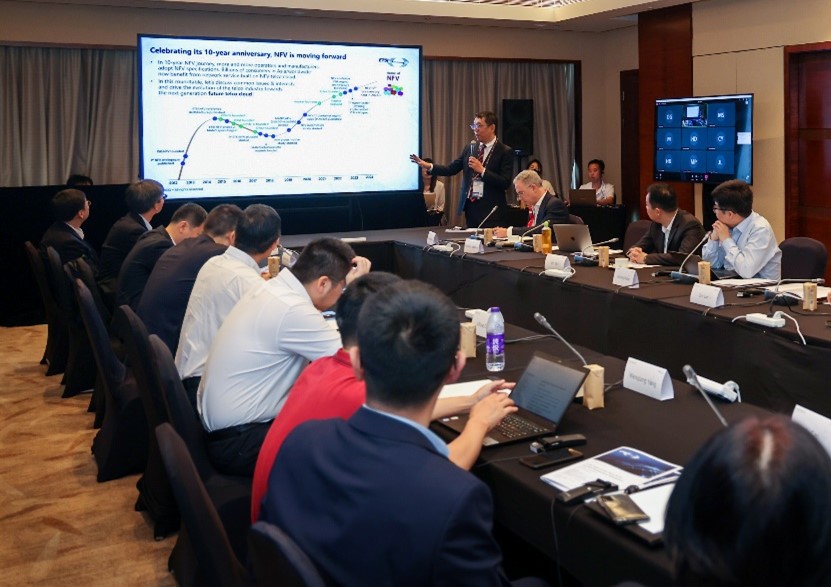
ETSI ISG NFV Chair, Yoshihiro Nakajima, gave the opening speech and pointed out that Asia-Pacific is pioneering the 5G SA global implementation, with NFV telco cloud providing the much-needed foundation for such deployments. Therefore, this roundtable was targeted to hear the learnings of the operators within this area and their thoughts on the NFV future evolution for supporting 5G-Advanced and beyond business. He also highlighted the main characteristics of the NFV community, being built on openness and collaboration; characteristics that were fundamental pillars for its 10-years successful journey to create globally adopted standards in the industry.
Meeting at ETSI headquarters of Sophia Antipolis in May-June has been always wonderful with a lot happening (local festivals, fun and adventure activities) in and around Nice, Antibes, Grasse and Cannes. It can be a time to rejuvenate yourself in this perfect weather. Some of us were happy to spend the weekend due to Technical Steering Committee (TSC) workshop on 1st and 2nd of June 2023. This year as well, we were greeted with gorgeous weather and wonderful gathering of NFV delegates onsite for NFV#42 happened between 5th to 9th of June. People who couldn't travel were able to join remotely for this plenary as well continuing the hybrid meeting practices.
During the opening plenary on 5th June, Madalin Neag (part of ETSI Secretariat) presented the agenda for NFV#42 plenary meetings, working group sessions and proposal for special ISG sessions during that week. ETSI ISG NFV chair, Yoshihiro Nakajima-san presented to the ISG on the latest accomplishments of the group and introduced the background on the special ISG sessions in NFV#42 plenary meetings. The special sessions were reserved to discuss the collaboration with other SDOs and to collect new ideas on, how to efficiently steer future work in the NFV. Madalin presented the progress made since NFV#41. The TSC manager, Ulrich Kleber then presented detailed status of Releases 4, 5 and 6, including:
- 24 normative specifications were published for edition 4.4.1 in Release-4.
- 6 informative group reports were published in Release-5.
Diego Lopez, chair of NFV’s NOC (Network Operator Council), shared this group’s views on the future of ISG, the challenges with Versioning of the specifications, view on Convergence of network models and the analysis, prioritization of new features in Release 6. The details and insights shared were appreciated and appropriate actions were noted by the ISG to follow-up.
When ETSI ISG NFV met in Sophia Antipolis recently for their 41st plenary meeting, it was not only collocating the 10 year anniversary celebration (see separate blog post here) with a week full of technical discussions. It was also a major step to provide the next package of specifications in NFV’s Release 4. The new package contains edition 4.4.1 documents for both stage 2 and stage 3.
In stage 2, 14 documents were updated mainly with maintenance. In addition, 2 new group specifications were published:
ETSI GS NFV-IFA 048, which adopts the State-Task design pattern to specify the NFV-MANO policy information model. The information elements in the model are transferred through policy management interfaces over NFV-MANO reference points, which enable the enforcement of policies in the framework of NFV-MANO. Stack-Task design pattern supports representing different policy expression forms and provides more flexibility and extensibility in respects to policy.
ETSI GS NFV-IFA 047, which specifies the service requirements as well as service interfaces produced by the MDAF (Management Data Analytics Function). Following the recommendations from a previous Release 4 group report ETSI GR NFV-IFA 041 on enabling autonomous management in NFV-MANO, this specification specifies a new function named MDAF (equipped with AI/ML models) and its service interfaces, which improve decision making of NFV-MANO in automation processes especially for network service management and orchestration.
In stage 3, there were 10 updated documents. The major highlights are described below:
ETSI GS NFV-SOL 018 - Profiling specification of protocol and data model solutions for OS Container management and orchestration:
The biggest part of the updates was about Cloud-Native VNFs and Container Infrastructure management. After the big leap forward in the support of containerized workloads in the NFV framework, which the previous edition 4.3.1 represented, the recently published 4.4.1 edition has brought additional support and consolidation of the feature.
The weather in Munich in late April was still a bit cold, but it did not prevent the ETSI NFV’s IFA working group (WG) from gathering in an interim face-to-face meeting under the warm hospitality of DOCOMO Euro-Labs. IFA WG is mainly responsible for delivering NFV stage 2 related specifications, including NFV architecture, interfaces and information model design, as well as informative work study on any new architectural related use cases exploring the evolution of NFV. This WG’s mission makes IFA an important WG within the ISG NFV, with always constant workload and substantial high-intense discussions.
The proposal for an interim IFA meeting was made during the NFV#41 plenary meeting, held in March this year, in order to address the amount of work to be completed by the WG by this summer. The proposal was endorsed by the Technical Steering Committee (TSC) and the ISG, as a whole. The interim WG meeting targeted to speed up the progress of active work items which are part of Release 4 and 5 and promote many of the work items to catch up with the upcoming summer release drop delivery timeline.
This interim meeting restarted the practice of past interim WG F2F meetings in ETSI NFV after 3 years’ hiatus due to the worldwide epidemic of COVID-19. The last memories of these interim meetings were from 2019, when IFA and SOL WGs jointly held interim meetings in Munich (same city, but with different hosting company) in March 2019. We would like to thank DOCOMO Euro-Labs for kindly hosting the interim WG meeting this time. Seven WG colleagues participated to the meeting on site and a dozen of other colleagues attended remotely.
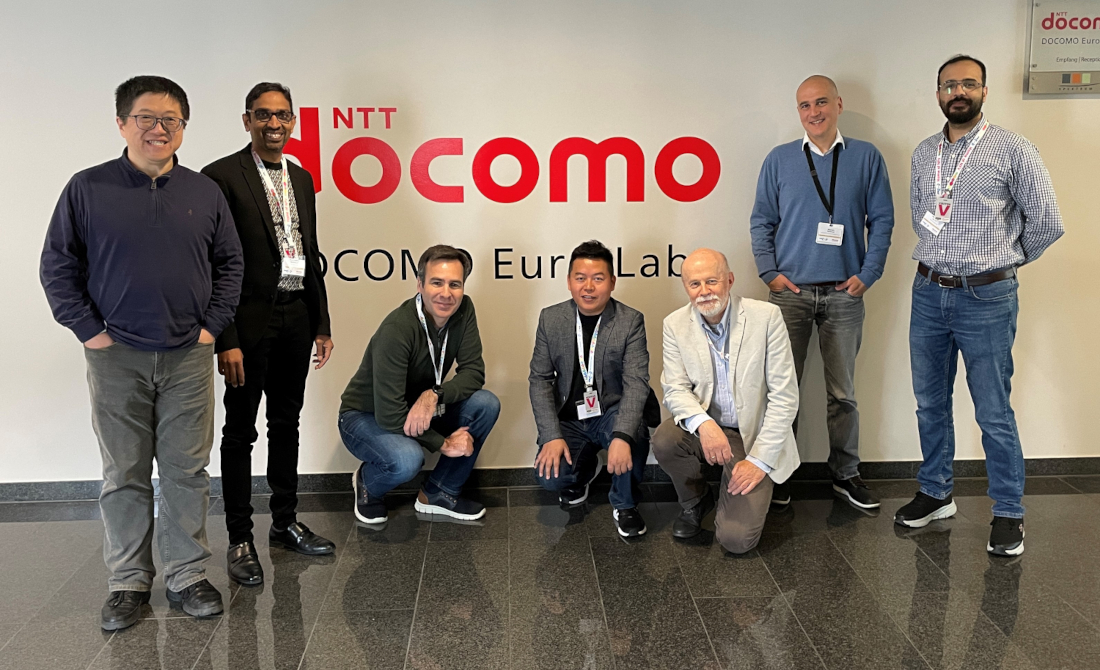
In early March, ETSI’s ISG NFV gathered again in ETSI headquarters in Sophia Antipolis. This 41st plenary meeting was collocated with a special event celebrating the 10 years anniversary of this very important Industry Specification Group adding together again many NFV friends from all around the world. (More details of NFV 10th anniversary can be found in the next post: https://www.etsi.org/newsroom/news/2204-etsi-s-conference-for-nfv-10th-anniversary-looks-to-the-future).
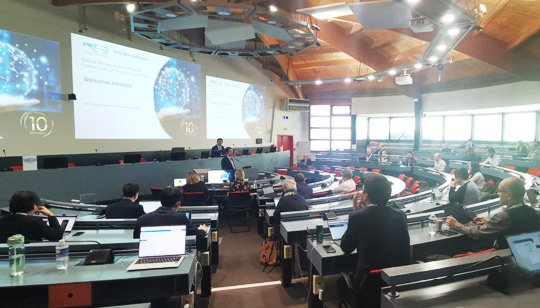 The NFV#41 opening plenary was held at the very beginning of the week. ETSI ISG NFV chair Yoshihiro Nakajima started by highlighting the achievements from the NFV#40 - ETSI ISG NFV continues to deliver with very good pace. As well, he took advantage to briefly announce the 10th anniversary event -a good opportunity to not only celebrate the accomplishments that NFV has made in the past 10 years, but also to look forward to the future.
The NFV#41 opening plenary was held at the very beginning of the week. ETSI ISG NFV chair Yoshihiro Nakajima started by highlighting the achievements from the NFV#40 - ETSI ISG NFV continues to deliver with very good pace. As well, he took advantage to briefly announce the 10th anniversary event -a good opportunity to not only celebrate the accomplishments that NFV has made in the past 10 years, but also to look forward to the future.
The TSC manager, Ulrich Kleber presented in depth the description of Releases 4 and 5, but also an overview of the Release 6. The updated schedule for those releases was detailed showing our group’s intention to speed up the standards’ creation process and alignment with the industry fast progress in this area.
Diego Lopez, NFV NOC’s chair, started his speech by talking about the recently-published NOC's white paper. He continued by sharing recent operators’ considerations on the relationship between ETSI standards and other cloud-related standards and specifications. Some proposals for future actions were triggered for the ISG including a more direct and dynamic interaction with open-source projects and convergence of K8s and NFV network models.
The ETSI Industry Specification Group (ISG) NFV has published the report ETSI GR NFV-IFA 039 titled " Report on Service Based Architecture (SBA) design ". This document is the first deliverable for the NFV Release 5 feature on “Service based architecture”.
Service based architecture (SBA) is an architectural style that places emphasis on the services provided by individual architectural components. Services are accessible over service interfaces, and are offered by service producers and consumed by service consumers. ETSI GR NFV-IFA 039 provides a feasibility study on the application of SBA design style to the NFV-MANO architectural framework specified in ETSI GS NFV 006. This includes - but is not limited to - studying aspects such as making interfaces independent from reference points, identifying new functionality related to NFV services like service registration or applying generalization for some services.
During early winter season, friends from ETSI ISG NFV gathered again at the beautiful riverside of the Thames, to promote the progress of the current active work items and meanwhile, standing at the milestone of 10 years’ point of time, foresee the next decade’s evolution of NFV with Release 6 planning. This meeting hosted by Huawei, was co-located with Layer123 World Congress 2022, which was held in the same building, Queen Elizabeth II Centre from December 5th to 7th. It was a great pleasure to see many familiar old faces who had deeply contributed to ETSI ISG NFV standards.
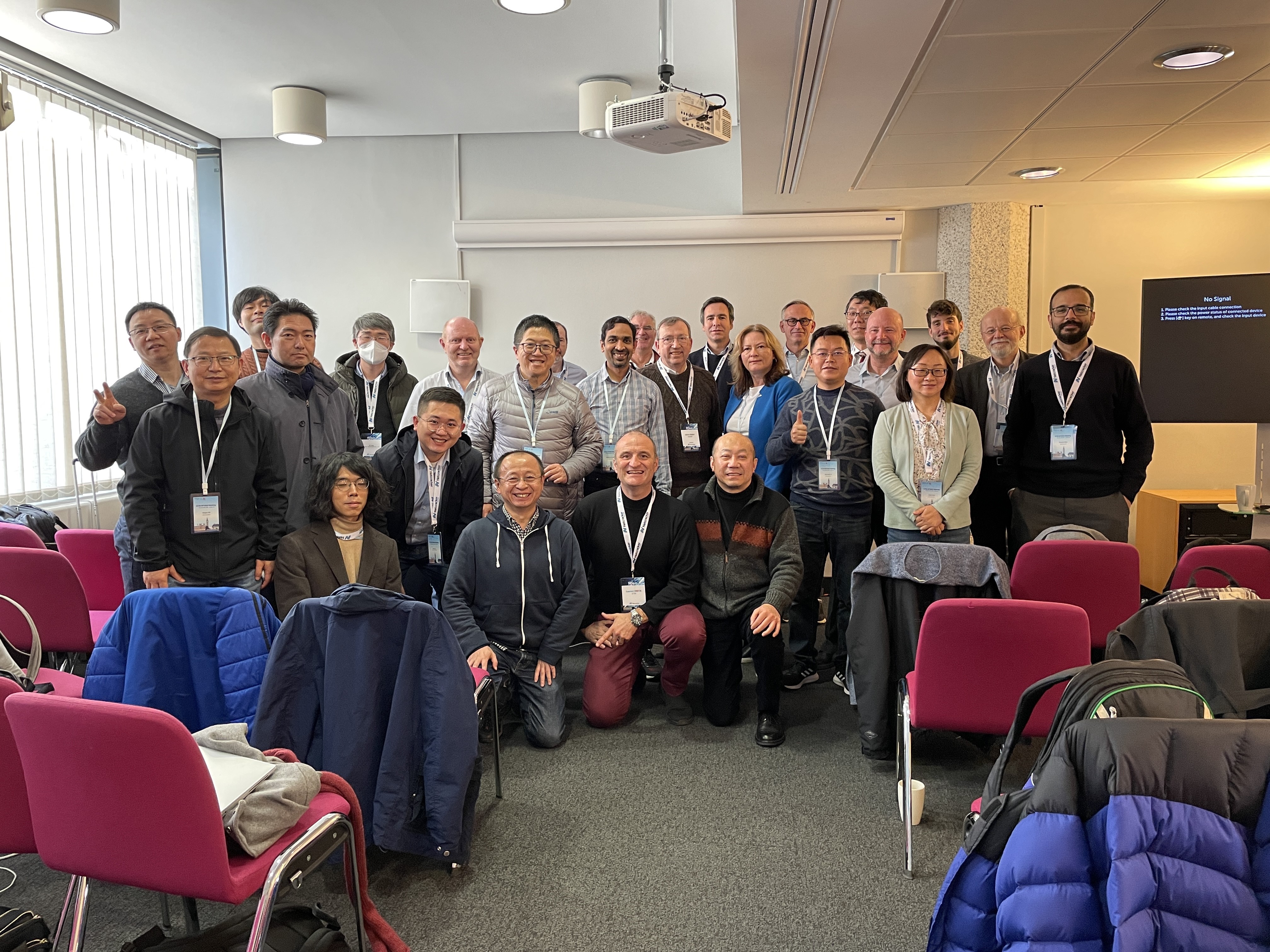
It was still a very busy and fruitful F2F meeting week with about 50 people’s participation on site. Both the number of delegates and contributions increased steadily from the previous NFV#39 meeting. During the 3 months since NFV#39 meeting, 1 stage 2 ed441 New WID and 1 super WID including 12 stage 3 ed441 specifications were approved, 29 final drafts including stage 2 and stage 3 ed371 specifications were published, and 5 final drafts including NFV006ed441 on MANO Architectural Framework were in ISG approval via remote consensus process. Highlights of NFV#40 meeting include:
- 5 New WID proposals were approved by the ISG:
- NWI proposal for CIS Cluster Management stage 3
- NWI on NFV-SOL018ed441 (reopening specification for profiling the service interfaces offered by Container Infrastructure Service Management (CISM))
- Maintenance of NFV terminology (NFV003)
- NWI for transforming release description to a group report
- NWI proposal on CCM-VIM Interoperability Interface and Information Model Specification
- Second round of feature proposal discussion on NFV Release 6
- Attend ETSI prospects workshop in Layer123 event
- Joint WG session to share information about Release 4 features tracking, OpenStack Tacker feedback and OAuth 2.0 scope
Over 50 delegates participated to this 39th meeting of ISG NFV which took place under the beautiful blue skies and very refreshing weather in the south of France. Although some of us were still unable to travel due to constraints caused by COVID-19. The face-to-face meetings resumed at the 39th ISG meeting, and I am very happy to be back and able to meet with you face-to-face in the ETSI building.
The standardization discussions in each working group during the meeting week were very efficient and steady, taking full advantage of the face-to-face discussions. The number of contributions has increased since the last meeting due to the situation where the confusion by COVID-19 is calming down. Thanks to the standardization delegates for their hard work! Four new Work Items and 22 final drafts were approved and published between the previous meeting and the 39th meeting.
The COVID-19 pandemic stopped ETSI NFV Industry Specification Group (ISG) face-to-face meetings for more than two years. As a result, the ISG blog posts for the plenary sessions were interrupted as well. Although people have been used to regarding online meetings as normal in the past two years, it is time now to call people back to face-to-face meetings with the gradual relaxation of epidemic prevention policies in many countries.
This time, the ETSI ISG NFV met again at NFV#38 from May 30th to June 3rd 2022, in Sophia Antipolis, France. The meeting took a hybrid format, ETSI headquarters hosted 23 delegates from Europe, Asia and North America. Many other delegates participated in the meeting remotely due to their inability to travel. This is the first time that ETSI NFV has returned to a face-to-face meeting after the COVID-19 pandemic since 2020.

A virtual event on NFV Evolution organized by ETSI in partnership with Telecom TV and sponsored by Huawei was held from 19 to 21 April 2021. The objective of the event was for the ETSI NFV Industry Specification Group (ISG) to get feedback from the industry on implementation experience with the ISG’s specifications and on future topics to be addressed in next specification releases. The event was also an opportunity for the participants to get updated on ETSI NFV’s activities, deliverables and future plans, as well as on the progress made in open source communities with regards to the convergence with the ISG’s standards. The event was held in parallel with the 34th meeting of the ISG. The choice was not accidental as this was the meeting where the ISG launched the process for collecting proposals from its members and participants on the features to be addressed within the scope of its next specification release (NFV Release 5).
The event programme featured six original presentations selected from the responses received to an open call, addressing deployment experience, new use cases and technical requirements:
- Mr. Yuya Kuno, NTT DOCOMO, presented DOCOMO’s experience in developing and operating NFV and future expansion.
- Mr. Pierre Lynch, Keysight Technologies and Ms. Silvia Almagia, ETSI CTI Technical Expert jointly presented “Measuring NFV Evolution: ETSI NFV Plugtests”.
- Mr. Borja Nogales, Universidad Carlos III de Madrid, presented “An NFV system to support service provisioning on UAV platforms: a walkthrough on implementation experience and standardization challenges”.
- Dr. Lingli Deng, China Mobile, presented “From Orchestration Towards Automation”
- Dr. Haopeng Zhu, Huawei Technologies Co., presented “Towards the future of NFV: Edge-native, Containerization, Networking-NFV convergence”.
- Mr. Gianpietro Lavado, Whitestack, presented about the advances in deployment of standardized NFV Orchestration through ETSI OSM.
2020 turned out to be an unexpected year, with the COVID19 pandemic adversely impacting the “normal” day-to-day lives of humans across the globe. However, even during this turn of events and unforeseen testing times, communication networks demonstrated their efficacy in keeping people and businesses connected. More concretely, Network Functions Virtualisation (NFV) proved its feasibility by enabling the operators to gracefully manage high demand for network connectivity.
 Undaunted by this situation, the technical experts at the ETSI ISG NFV continued to work tirelessly developing and delivering specifications that help get and keep “everyone/everything connected”. And the hard work paid off as ETSI ISG NFV delivered during the second half of 2020 new and updated "protocols and data model" (stage 3) specifications incorporating NFV Release 3 features.
Undaunted by this situation, the technical experts at the ETSI ISG NFV continued to work tirelessly developing and delivering specifications that help get and keep “everyone/everything connected”. And the hard work paid off as ETSI ISG NFV delivered during the second half of 2020 new and updated "protocols and data model" (stage 3) specifications incorporating NFV Release 3 features.
The experts in the Solutions (SOL) working group completed stage 3 work on a subset of the NFV Release 3 features. One of the first features that was already finalised in 2019 was "Management of NFV-MANO" (FEAT11) with the release of ETSI GS NFV-SOL 009 V3.3.1. This document specifies a set of RESTful protocols and APIs that can be used to manage different aspects regarding configuration, performance, fault and logging of entities implementing specified NFV-MANO functional blocks. The defined APIs leveraged the same RESTful principles used for NFV-MANO APIs in Release 2, i.e., the ones used for managing VNF instances, NS instances and on-boarding VNF Packages, NSDs and other artefacts.
New outcomes on the development of NFV-MANO APIs continued in 2020 with the release of ETSI GS NFV-SOL 011 V3.3.1, which specifies NFV-MANO APIs related to management across "NFV-MANO administrative domains" (FEAT08). These APIs are produced by the NFVO and allow different administrative domains to communicate over the Or-Or reference point to help coordinate the management of NS instances deployed on their respective administrative domains. The Or-Or reference point is set in between NFVO instances placed on different administrative domains, as specified in ETSI GS NFV-IFA 030. For instance, the APIs of ETSI GS NFV-SOL 011 enable reusing an NS instance deployed on a domain A and nest it into another NS instance deployed on a domain B. Due to the functional similarities with existing capabilities offered by the NFVO to other systems such as OSS/BSS, most of the APIs are identical or based on those specified in ETSI GS NFV-SOL 005.
The ETSI Industry Specification Group (ISG) NFV has published the initial release of ETSI GS NFV-IFA 040 titled "Requirements for service interfaces and object model for OS container management and orchestration specification". This document is the first normative specification delivered for the NFV Release 4 feature on “Cloud-native VNFs and Container Infrastructure management”. The specification propagates the recommendations from the study in ETSI GR NFV-IFA 029 and formally specifies the new functions required for the management and orchestration of OS containers, the Container Infrastructure Service Management (CISM) and the Container Image Registry (CIR). The CISM is responsible for maintaining the containerized workloads while the CIR is responsible for storing and maintaining information of OS container software images.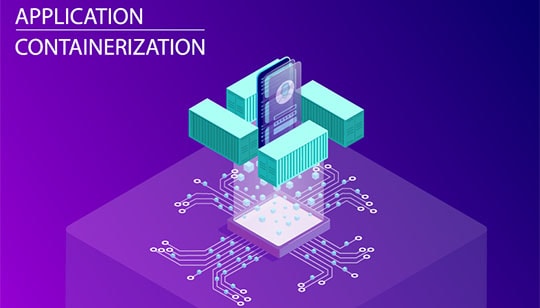
To enable a consistent and generic system for the management of containerized VNFs, ETSI GS NFV-IFA 040 specifies an abstract NFV object model for OS container management and orchestration, including their relationship to the core information models of NFV-MANO. The abstract NFV objects are also expected to be used in specifications profiling APIs of de-facto standard solutions, to map the abstract NFV objects to objects of the specific de-facto standard solution. One of the introduced abstract NFV objects is the Managed Container Infrastructure Object (MCIO), an object managed and exposed by the CISM, characterized by the desired and actual state of a containerized workload. Managed objects from Kubernetes® such as Deployment or Service are examples which map to an MCIO. Another new NFV object is the Managed Container Infrastructure Object Package (MCIOP), a hierarchical aggregate of information objects including declarative descriptors and configuration files for one or multiple MCIOs. Helm charts as specified by CNCF® are an example which maps to an MCIOP.
ETSI GS NFV-TST 010 (TST010) is a published API conformance testing specification for NFV Management and Orchestration (NFV-MANO) APIs. Specifically, it contains conformance tests for the APIs used on the following reference points:
- Os-Ma-Nfvo, defined by ETSI GS NFV-SOL 005 (SOL005)
- Ve-Vnfm, defined by ETSI GS NFV-SOL 002 (SOL002)
- Or-Vnfm, defined by ETSI GS NFV-SOL 003 (SOL003)
The latest released version of TST010 is Version 2.6.1 (available from the ETSI website), which means that it supports the corresponding 2.6.1 versions of the above SOL documents (i.e. SOL02, SOL003 and SOL005). Version 2.4.1 is also available, and it similarly corresponds to the 2.4.1 versions of the SOL documents. This will always be the case going forward as well: the TST010 version will always match the corresponding version of the SOL documents specifying the reference points being tested.
The ETSI NFV Industry Specification Group (ISG) has completed the initial release of ETSI GS NFV-SOL 014 titled "YAML data model specification for descriptor-based virtualised resource management". The specification focuses on a set of YAML-based data models used between NFVO and VIM (Or-Vi reference point), and also between VNFM and VIM (Vi-Vnfm reference point) for exchanging information on virtualised resources and their management. The work item and resulting document addresses specification gaps in the area of virtualised resource management and aim at enhancing the integration and interoperability of VNFM and NFVO with VIM solutions.

In the ETSI NFV specifications, interfaces and information models for the Or-Vi and Vi-Vnfm reference points have been specified in ETSI GS NFV-IFA 005 and ETSI GS NFV-IFA 006 respectively. Based on those specifications, the objective of ETSI GS NFV-SOL 014 is to define a set of YAML-based data models for representing information exchanged over these reference points as input and outputs to perform virtualised resource management. The descriptor-based virtualised resource management assumes a type of VIM which supports templates declaring parameters, requirements, lifecycle and composition of sets of virtualised resources.
Following intense technical work, ETSI NFV has just released ETSI GS NFV-SOL 016, the first stage 3 specification of NFV-MANO procedures in NFV Release 2 addressing interactions across several NFV-MANO functional blocks and/or interfaces. This specification builds on the ETSI NFV-MANO API specifications ETSI GS NFV-SOL 005, ETSI GS NFV-SOL 003 and ETSI GS NFV-SOL 002 which have defined the mandatory and optional operations and data attributes per individual NFV-MANO interface. As these specifications are focusing on individual interfaces, it is left up to the operator or the integrator to stitch together the information across different NFV-MANO interfaces to realize the NFV-MANO procedures involving interactions across several NFV-MANO functional blocks and/or interfaces, also referred to as end-to-end procedures. This might lead to various interpretations of how the end-to-end NFV-MANO procedures should work. ETSI GS NFV-SOL 016 defines procedures for selected key NFV-MANO procedures with the target to improve interoperability end-to-end.

The ETSI NFV community met for its twenty ninth plenary meeting (NFV#29) from 17 to 21 February at the Home of NFV, ETSI Headquarters, in Sophia-Antipolis, France. This time, the plenary meeting took place amidst the unfortunate situation, the Coronavirus outbreak that has hit so many countries and seriously impacted standardization work, and life in general almost worldwide. Consequently, some of our delegates were not able to travel and attend the meeting physically. Our best wishes to all of you all around the world who have been impacted by the outbreak, "wishing you a good and quick recovery".
Addressing the impact of this outbreak on the handling of the plenary meeting, ETSI provided outstanding support, as usual, by enabling remote access for participants that could not travel. Furthermore, the ISG and working group officials made a very good job of adapting the schedule and working procedures to facilitate the active participation and contributions of the remote delegates. As for those of us that had the opportunity to attend the plenary physically, ETSI had provided a very useful new facility: the delegates participating F2F could check-in for the first time by scanning their meeting QR code using a check-in station in the ETSI lobby. 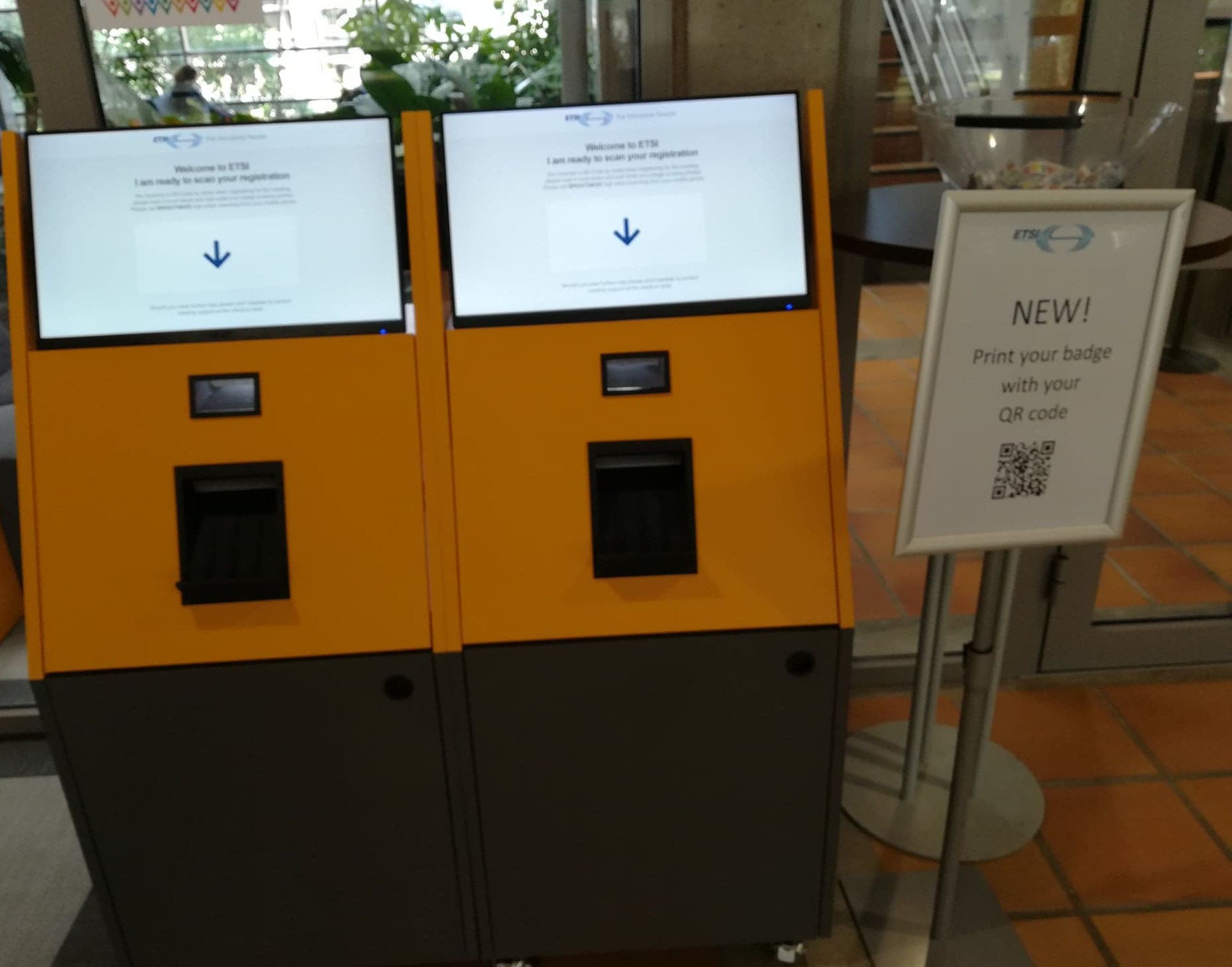
All in all, despite the circumstances, the plenary meeting was once again a success. All working groups made steady progress in most of the work items that are currently being developed as part of the Releases 3 and 4.

